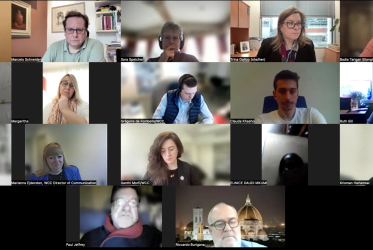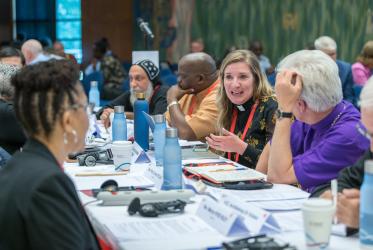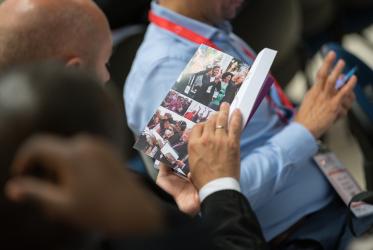Introduction
Methodism emerged as a renewal or missional movement from within the Church of England. Therefore where Ascension Day is celebrated by Methodist people, they readily retain Anglican liturgical tradition or borrow liturgy from other Protestant traditions. However, strands of early Methodism took a more charismatic or “primitive” direction and, with an emphasis on evangelistic preaching and extempore prayer, tended toward suspicion of written liturgies, lectionaries, sacramentalism, and perhaps even of “tradition” itself. A tradition that unites all Methodists is that of singing the faith, such that hymns take a very prominent place in enabling worthy worship and articulating the content of our faith.
Charles Wesley’s 1746 Hymns on the Great Festivals and Other Occasions includes three on nativity, four on crucifixion, three on resurrection, three on ascension, and three on Whit-Sunday (Pentecost). The cross was central to Wesley’s faith and hymnody but, perhaps surprisingly, he tended to treat the resurrection of Christ as somewhat secondary to Christ’s ascension – or perhaps he regarded the Lord’s rising from the grave and into heaven as two aspects of the one triumphal procession.
Here are some lines from Charles Wesley, expressing faith and theology, in hymns for resurrection and ascension that are still regularly sung in Methodist churches today:
Jesus the Saviour reigns,
The God of truth and love,
When He had purged our stains,
He took His seat above
(From “Rejoice the Lord is King”)
Soar we now where Christ has led, Alleluia!
Following our exalted Head, Alleluia!
Made like him, like him we rise, Alleluia!
Ours the cross, the grave, the skies, Alleluia!
(From “Christ the Lord Is Risen Today”)
Him tho’ highest Heaven receives, still he loves the Earth he leaves;
Tho’ returning to his Throne, Still he calls Mankind his own.
See! He lifts he Hands above! See! He shews the Prints of Love!
Hark! His gracious Lips bestow blessings on his Church below!
Still for us his Death he pleads; prevalent, He intercedes;
Near Himself prepares our place, harbinger of human race.
(From “Hail the Day that Sees Him Rise”)
Bible passage: Ephesians 4:1-16
I therefore, the prisoner in the Lord, beg you to lead a life worthy of the calling to which you have been called, with all humility and gentleness, with patience, bearing with one another in love, making every effort to maintain the unity of the Spirit in the bond of peace. There is one body and one Spirit, just as you were called to the one hope of your calling, one Lord, one faith, one baptism, one God and Father of all, who is above all and through all and in all.
But each of us was given grace according to the measure of Christ’s gift. Therefore it is said,
“When he ascended on high he made captivity itself a captive; he gave gifts to his people.”
(When it says, “He ascended”, what does it mean but that he had also descended into the lower parts of the earth? He who descended is the same one who ascended far above all the heavens, so that he might fill all things.) The gifts he gave were that some would be apostles, some prophets, some evangelists, some pastors and teachers, to equip the saints for the work of ministry, for building up the body of Christ, until all of us come to the unity of the faith and of the knowledge of the Son of God, to maturity, to the measure of the full stature of Christ. We must no longer be children, tossed to and fro and blown about by every wind of doctrine, by people’s trickery, by their craftiness in deceitful scheming. But speaking the truth in love, we must grow up in every way into him who is the head, into Christ, from whom the whole body, joined and knitted together by every ligament with which it is equipped, as each part is working properly, promotes the body’s growth in building itself up in love.
Reflection
If you are following this study in a group (especially an ecumenical group), there may be a desire to project and protect your self-identity or group identity – and a desire to be “right.” This would be to resist and to thwart the very message of this scripture. Please don’t rush on to see what I have to say about this passage before spending time relishing God’s word and slowly savouring it with the help of the Holy Spirit. There is a danger that we hurry forward, wanting answers or an intellectual understanding, and trying to define or control the word of God. Instead, with a vulnerable openness to the movement of God’s Holy Spirit, read the passage through slowly, several times. Then perhaps read it again from a different translation – or, if you are multilingual, in a different language. Read what precedes and what follows this short section. What words or phrases resonate with you? Where do you sense a movement in your spirit? We ask God to open the eyes of our heart (Eph. 1:18), to comprehend the immense scope of God’s love and grace toward us, and to be filled with all the fullness of Christ. We are to approach with humility and awe – to enter into this mysterious plan of God – arising out of God’s love and fulfilled in unity.
The message of Ephesians can be summed up very simply in two main parts. The first three chapters expound on the mysterious plan of God to bring reconciliation and unity – to end division and alienation – and to bring together all things in Christ. The second half of the letter exhorts us to live up to this calling. There is a call to individual Christians to reconcile and be united, but also a call to the church to demonstrate to the world an embodying of this reconciliation and unity. The ascension of Christ is a central and dynamic sign of the bringing together of heaven and earth, with Christ taking “up” the human and the earthly into the heart of God and triggering the promised movement of the heavenly “down” into human hearts through the sending of the Holy Spirit.
Ascending and descending feature as movements of God and of God’s people throughout the Bible. For God’s people, this may be physical movement (up and down the mountain), liturgical movement (going up to the mercy seat), and spiritual movement (Paul caught up into a vision of paradise [2 Cor. 12:4]). These movements are, however, primarily relational rather than spatial, indicating alienation or reconciliation, exclusion or embrace. The Messiah was longed for, and Jesus appeared, as the one who would bridge this gap, once and for all.
Rather than understanding the ascension as the climax of Jesus’ mission of atonement, and a visible sign of this reconciliation between heaven and earth, some have rejected a very literal interpretation of the ascension (Jesus shooting up to the stars). The rational sceptic tends to feel condescendingly superior, but without a proper humility before the mystery of God’s creation. Western Christianity has often gotten stuck “in the head,” proliferating competing arguments (winds of doctrine?) while avoiding the spiritual wisdom and discernment of the heart. Running alongside this can be the unhelpful suspicion of anything “bodily” – and so we miss the good news that Jesus has a bodily resurrection and a bodily ascension. The heavenly and the earthly are two aspects or dimensions of God’s good creation.
In the Isle of Man, we have the Celtic tradition of “thin places”: places where there seems to be no distance at all between heaven and earth, places where the veil or the wall between the two dimensions is so thin that we sense the consummation of this union between heaven and earth. These places are often in the margins or at places of transition, where earth meets sea (cliffs and shorelines), where earth meets sky (hills and mountains), or where water gushes out of the earth (springs, waterfalls, and perhaps wells). In some of these places you can still see the remains of the keeills – small chapels, cells, or hermitages. Mostly isolated and inaccessible, keeills were located for a life of prayer rather than to accommodate or attract the masses. For example, Lag ny Keeilley (Hollow of the Chapel) is nestled on a ledge where the “Hill of the Rising Day” (Cronk-ny-Irree-Laa) falls into the sea – and here it is said that the old Manx folk used to put their ears to the ground to hear the sounds of infinity (Sheean-ny-Feaynid).
This raises for me the question of whether human beings can become “thin places” – either individually or as a “body” or as a church. You may have noticed while reading the New Testament that disciples inhabit the gospels and the early church in Acts, but in the epistles, disciples disappear, becoming “brothers and sisters” with a calling to be “saints.” The ascension is again a turning point. Believers can no longer follow Jesus because he is absent from earth and enthroned as Lord. Jesus Christ is Lord, but not distant from us as he fills all things (Eph. 4:10), including the saints (us) through the work of the Holy Spirit. So we are called to be built together spiritually into a dwelling place for God (Eph. 2:22) and to attain the full stature of Christ (Eph. 4:12). It seems to me, then, that if we find unity in Christ, and the “oneness” described in verses 4 to 6, we ourselves can become “thin places” where dimensions collide, and earth is kissed by heaven.
Questions for further reflection
- The passage starts with bearing one another in love (v. 1) and ends with building the body in love (v. 16). Social psychology tells us that the human mind works to categorize things and people into groups. Unconsciously, we accentuate the differences between groups and we compare and compete in order to feel good about ourselves. This is at the root of so many 21st-century conflicts, and it drives all forms of discrimination and failure to honour the equal worth and dignity of every human person. Do our denominational conflicts disqualify us from pointing out the speck in other people’s eyes?
- If this calling to unity is so central to our calling and our aspiration, why is God not glorified by the actual and visible unity of the body of Christ on earth? There is obviously nothing lacking in the overflowing love and gifts of grace that we have already received in Christ – so what is it that thwarts the unity of the church?
- Verse 12 talks about equipping the saints for the work of ministry – a ministry of unity. This is very much a communal work. We could read into verse 11 a hierarchy of gifts, but the purpose and goal of all the gifts is for equipping and building saints together into unity and maturity in Christ. This is encouraging us to recognize the ministry of every Christian – and recognize a shared ministry. Gifts are given to everyone (v. 7). How does your tradition encourage the ministry of the whole people of God? Who are the apostles, the teachers, and so on? Could these be other than priests, pastors, and theologians? Could the teachers we need be, for example, Indigenous people? Can we hear the prophecies of overlooked saints in the pews?
- The body of Christ is a great image for unity in diversity. Can you play with this image and explore what it means, not just for your particular gathered community of Christians, but for the whole household of God? In this passage we see the first sketching of an understanding of God’s triune nature – God’s unity in diversity. Can we experience the three infoldings of God (from the German Dreifaltigheit) as an invitation to join in the dancing circle of God (from the Greek Perichoresis) rather than an invitation to doctrinal arguments? As the ballerina Isadora Duncan said, “If I could tell you what it meant, there would be no point in dancing it.”
- The taking up of the human, and the material, into heaven – and the longing for the final consummation of heaven and earth – has important implications for our relationship with our planet and the whole created order. If God is going to incinerate the world at the end of time, what point is there in taking care of it now? If bodies are “disposable,” we can treat them with contempt. But what if God is “in all,” and Christ ascended to “fill all things”? What difference does it make if we know every scar inflicted on earth will be incorporated into the new creation?
Prayer
For this reason I bow my knees before the Father, from whom every family in heaven and on earth takes its name.
I pray that, according to the riches of his glory, he may grant that you may be strengthened in your inner being with power through his Spirit, and that Christ may dwell in your hearts through faith, as you are being rooted and grounded in love.
I pray that you may have the power to comprehend, with all the saints, what is the breadth and length and height and depth, and to know the love of Christ that surpasses knowledge, so that you may be filled with all the fullness of God.
Now to him who by the power at work within us is able to accomplish abundantly far more than all we can ask or imagine, to him be glory in the church and in Christ Jesus to all generations, for ever and ever. Amen. (Ephesians 3)
Hymn: “One Human Family God Has Made”
One human family God has made,
and all for each to care.
One world, to be the home of all,
with all its wealth to share.
One Christ, to manifest on earth
love’s ultimate design.
One Church to know the mystery
of broken bread and wine.
One race, one world – yet torn apart,
We spurn the way of love.
But still ahead, the Christ leads on
And calls his Church to move
From love of power to power of love,
To give the word to all –
To trust the love that conquered death,
Outside the city wall.
And are we brave enough to join
With that great company –
The cost not less than all we have
And are or hope to be –
The bitter cup of human sin
To drink with him who died,
And take his love outside the wall
To all the crucified?
Claim him who claims us for his own,
To share his pain and grief,
To bear the scars that stamp us his –
The hallmark of belief.
As partners of the living Christ,
Who risk the path he trod,
With wondering love we find we share
The timeless joy of God.
Rosemary Wakelin [b. 1932]; Singing the Faith, 687
Used with permission of the author
About the author
Janet Corlett is a presbyter of the Methodist Church in Britain and vice-moderator of the WCC Commission on World Mission and Evangelism. She has worked as an agricultural scientist in India and Zimbabwe and as a mission partner in Honduras. She is Manx by birth, and her faith has roots in the Celtic spirituality of the Isle of Man.






